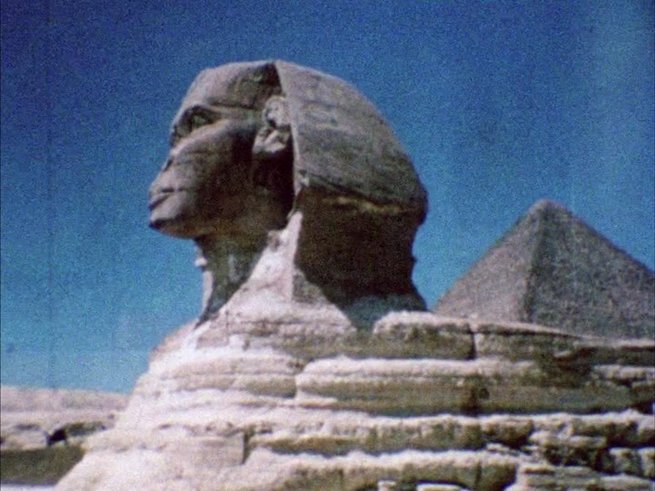Camera Austria | Graz
11. Juni – 14. August 2022
Intersections in Theory, Film, and Art
Laura Mulvey & Peter Wollen
Laura Mulvey & Peter Wollen, Still aus: Riddles of the Sphinx, 1977.
Laura Mulvey und Peter Wollen sind vor allem als Filmtheoretiker*innen und Filmemacher*innen bekannt. So haben sie zum Beispiel mit Mulveys »Visual Pleasure and Narrative Cinema« (dt. »Visuelle Lust und narratives Kino«) und Wollens »The Two Avant-Gardes« (beide 1975) enorm einflussreiche Beiträge zur Filmtheorie verfasst und zwischen 1974 und 1983 sechs Filme miteinander gedreht. Darin suchten sie nach Formen, die den herrschenden Sprachen des Schauens, der Signifikation und der Narration nachspürten und ihnen etwas entgegensetzten, das den*die Betrachter*in in eine theoretische Debatte verwickelte.
In ihren Schriften wie in ihrer filmischen Arbeit lassen sie Semiotik, Feminismus, Psychoanalyse, Geschichte und Theorie der Avantgarde miteinander in Kontakt treten. Diese Interessen werden – wiewohl unterschiedlich moduliert und umgearbeitet – auch in den Projekten fortgeführt, die sie ab Mitte der 1980er-Jahre unabhängig voneinander realisiert haben.
Die Ausstellung bei Camera Austria eröffnet neue Wege zum Verständnis ihres Werks, indem sie Mulveys und Wollens vielfältige Auseinandersetzung mit Fotografie ins Zentrum rückt: Dokumentationen über Künstler*innen, die mit Fotografie arbeiteten; Theoriefilme, die den kinematografischen – und also fotografischen – Blick reflektieren und hinterfragen; zahlreiche kritische Essays zur Fotografie sowie ihrer Beziehung zu anderen kulturellen Formen und ihre Rolle als Gesprächspartner*innen für mit Fotografie arbeitende Künstler*innen.
Laura Mulvey et Peter Wollen sont surtout connus en tant que théoriciens du cinéma et cinéastes. Avec "Visual Pleasure and Narrative Cinema" de Mulvey et "The Two Avant-Gardes" de Wollen (tous deux publiés en 1975), ils ont apporté des contributions très influentes à la théorie du cinéma et ont tourné six films ensemble entre 1974 et 1983. Ils y recherchaient des formes qui traquaient les langages dominants de la vision, de la signalisation et de la narration et qui leur opposaient quelque chose qui impliquait le spectateur dans un débat théorique.
Dans leurs écrits comme dans leur travail cinématographique, elles font entrer en contact la sémiotique, le féminisme, la psychanalyse, l'histoire et la théorie de l'avant-garde. Ces intérêts se poursuivent - bien que modulés et remaniés différemment - dans les projets qu'elles ont réalisés indépendamment l'une de l'autre à partir du milieu des années 1980.
L'exposition de Camera Austria ouvre de nouvelles voies à la compréhension de leur œuvre en mettant l'accent sur les multiples confrontations de Mulvey et Wollen avec la photographie : des documentaires sur des artistes qui ont travaillé avec la photographie ; des films théoriques qui réfléchissent et remettent en question le regard cinématographique - et donc photographique - ; de nombreux essais critiques sur la photographie ainsi que sur sa relation avec d'autres formes culturelles et leur rôle d'interlocuteurs pour les artistes* travaillant avec la photographie.
Laura Mulvey e Peter Wollen sono noti soprattutto come teorici del cinema e registi. Ad esempio, con "Visual Pleasure and Narrative Cinema" di Mulvey e "The Two Avant-Gardes" di Wollen (entrambi del 1975), hanno scritto contributi enormemente influenti sulla teoria cinematografica e hanno realizzato insieme sei film tra il 1974 e il 1983. In essi hanno cercato forme che ricalcassero i linguaggi dominanti dello sguardo, della significazione e della narrazione e li contrastassero con qualcosa che coinvolgesse lo spettatore in un dibattito teorico.
Nei loro scritti e nel loro lavoro cinematografico, mettono in contatto semiotica, femminismo, psicoanalisi, storia e teoria dell'avanguardia. Questi interessi - seppur modulati e rielaborati in modo diverso - sono proseguiti anche nei progetti che hanno realizzato in modo indipendente a partire dalla metà degli anni Ottanta.
La mostra di Camera Austria apre nuovi modi di comprendere il loro lavoro, concentrandosi sul multiforme impegno di Mulvey e Wollen con la fotografia: documentari su artisti che hanno lavorato con la fotografia; film teorici che riflettono e mettono in discussione lo sguardo cinematografico - e quindi fotografico -; numerosi saggi critici sulla fotografia e il suo rapporto con altre forme culturali e il loro ruolo di interlocutori per gli artisti che lavorano con la fotografia.
Laura Mulvey and Peter Wollen are best known as film theorists and filmmakers. As writers, they made highly influential interventions in film theory such as Mulvey’s Visual Pleasure and Narrative Cinema and Wollen’s The Two Avant-Gardes (both 1975). Between 1974 and 1983, the duo made six films together, seeking cinematic forms that investigated and countered dominant languages of looking, signification, and narration, and that could engage the viewer in conceptual debate. Across writing and filmmaking, their works bring into contact semiotics, feminism, psychoanalysis, and histories and theories of the avant-garde.
These concerns, although modulated and reworked in different ways, continue in the projects they undertook separately from the mid-1980s onward.The exhibition at Camera Austria opens up new ways of understanding this body of work by foregrounding Mulvey and Wollen’s multiple engagements with photography, including documentaries about artists working with photography (such as Tina Modotti and Milton Rogovin); theory films that reflect and challenge the cinematic, and hence photographic, gaze itself; numerous critical essays on photography and its relationship to other cultural forms; and their role as important interlocutors for artists working with photography.
(Text: Camera Austria, Graz)

